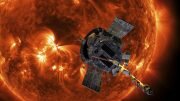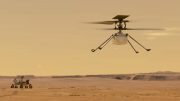The NASA-sponsored Haughton-Mars Project announced tonight the successful testing of the Norwegian concept of an “Astronaut Smart Glove” for future human exploration of the Moon, Mars and space.
The Norwegian company Ntention has developed the smart Sensor Glove that allows astronauts to wirelessly operate robots, drones and other machines – through simple hand gestures. Using advanced software, the glove understands body language and performs various actions based on the user’s movements. If you tilt your hand to the left, the drone will turn left. If you pinch your hand, the robot will perform the desired action you have trained it to do.
-” We are pleased to see that a Concept Space Suit equipped with a Smart Glove could be the astronaut’s solution to control a variety of robotic activities, making research and research on the Moon, Mars and other destinations in space easier to perform,” says Pascal Lee, planetary scientist at the SETI Institute and the Mars Institute, and director of the NASA Haughton-Mars project at the NASA Ames Research Center, in a press release from the SETI Institute.
Despite the extreme conditions the space suits will operate under, the suits must also allow astronauts to perform delicate and complex operations. Today’s pressurized space suits make it challenging to pinch your fingers or control robots with remote controls. With the Ntention sensor-based Smart Glove, the same operations can be performed with smaller and intuitive movements, making it adaptable for use in space suits.
Successful test on Devon Island
The founders Moina Medbøe Tamuly and Magnus Arveng was discovered by Dr. Lee when Tamuly conducted a demonstration of its technology, during this year’s Energy Valley conference.
– I used our glove to control a drone when we met Dr. Pascal Lee. It soon became clear that we shared many of the same dreams and visions for what this technology can be used for, Tamuly says.
A short time later, the company was invited to a research- and verification project through NASA-supported Haugthon-Mars Project in Canada. Through a collaboration between the SETI Institute, the Mars Institute, NASA Ames Research Center and Collins Aerospace, the childhood dream came true. Tamuly and the rest of the team got to implement their technology in next-generation space suits, as well as testing the “Astronautic Smart Glove” in the field.
– We got the opportunity to experience Devon Island – which I would like to describe as one of the most magical places a human can experience on earth. And as if that’s not enough, we got inspiration and drive to further verify the technology with top notch researchers in the field, as well as further develop the technology that makes the interface between humans and machines intuitive and seamless, co-CEO and co-founder Tamuly adds.
Now, barely two months after the research project began, the NASA Haugthon-Mars Project can announce that the field tests on Devon Island were successful.
– Impressive what they’ve got
Norway’s Business Application Ambassador for the European Space Agency, Kristine Koslung is very impressed with what the team has been up to in recent months.
– The company has shown that they have great execution power and the ability to make the right contacts. In addition to the NASA-supported Haughton-Mars Project, Ntention has also completed assignments for Norconsult over the past few months, Koslung reports.
She is also not so sure that everyone is able to take in how spectacular and peculiar this project is.
– It is a Norwegian company made up of young students who have managed to land a field project with some of the world’s largest players in space and human exploration of Mars – it is quite incredible. Leading researchers in the field boast of the young team and their technology, she continues.
May join the moon in 2024
By mid-October, NASA released the space suits that will be used by American astronauts when they return to the moon in 2024, under the Artemis program.
NRK……Her er romdrakten Nasa skal bruke på månen
Moina Medbøe Tamuly may reveal that it was a concept space suit developed by the same company (Collins Aerospace) they used during testing on Devon Island.
© #Norway Today




Be the first to comment on "NASA partner tests Norwegian sensor glove – potentially for use on the moon and Mars"